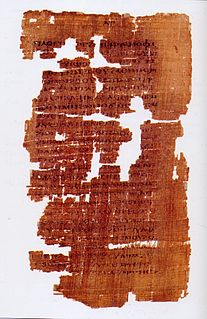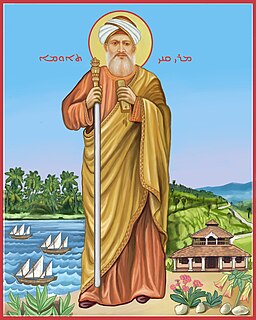
The Apostles' Creed, sometimes titled the Apostolic Creed or the Symbol of the Apostles, is a Christian creed or "symbol of faith".
Thomas the Apostle, also known as Didymus, was one of the Twelve Apostles of Jesus according to the New Testament. Thomas is commonly known as "Doubting Thomas" because he initially doubted the resurrection of Jesus Christ when he was told of it ; he later confessed his faith on seeing the wounds left over from the crucifixion.
Bibliomancy is the use of books in divination. The method of employing sacred books for 'magical medicine', for removing negative entities, or for divination is widespread in many religions of the world.

The New Testament apocrypha are a number of writings by early Christians that give accounts of Jesus and his teachings, the nature of God, or the teachings of his apostles and of their lives. Some of these writings were cited as scripture by early Christians, but since the fifth century a widespread consensus has emerged limiting the New Testament to the 27 books of the modern canon. Roman Catholic, Eastern Orthodox, and Protestant churches generally do not view the New Testament apocrypha as part of the Bible.
Legend makes Abdias first bishop of Babylon and one of the Seventy Apostles who are collectively mentioned in the Gospel of Luke10:1–20. Saints Simon and Jude allegedly consecrated him as the first Bishop of Babylon. He is also associated with St. Thomas, the Apostle and is associated with St.Addai, recognized as the first Patriarch of the Church of the East in Syriac Christianity.
Sortes Sanctorum is a late antique text that was used for divination by means of dice. The oldest version of the text may have been pagan, but the earliest surviving example—a 4th- or 5th-century Greek fragment on papyrus—is Christian. The original version had 216 answers available depending on three ordered throws of a single die. It was later revised down to 56 answers for a single throw of three dice. This version was translated into Latin by the time of the council of Vannes (465), which condemned its use. The Latin version was subsequently revised to render it more acceptable to ecclesiastical authorities. This Latin version survives in numerous manuscripts from the early 9th century through the 16th, as well as in Old Occitan and Old French translations. Beginning in the 13th century, the text was sometimes known as the Sortes Apostolorum, a title it shares with at least two other texts.

The Apostolic Canons, also called Apostolic canons, Ecclesiastical Canons of the Same Holy Apostles, or Canons of the Holy Apostles, is a 4th-century Syrian Christian text. It is an Ancient Church Order, a collection of ancient ecclesiastical canons concerning the government and discipline of the Early Christian Church, allegedly written by the Apostles. This text is an appendix to the eight book of the Apostolic Constitutions. Like the other Ancient Church Orders, the Apostolic Canons uses a pseudepigraphic form.

The Epistle of the Apostles is a work of New Testament apocrypha. Despite its name, it is more a gospel or an apocalypse than an epistle. The work takes the form of an open letter purportedly from the remaining eleven apostles describing key events of the life of Jesus, followed by a dialogue between the resurrected Jesus and the apostles where Jesus reveals apocalyptic secrets of reality and the future. It is 51 chapters long. The epistle was likely written in the 2nd century CE in Koine Greek, but was lost for many centuries. A partial Coptic language manuscript was discovered in 1895, a more complete Ethiopic language manuscript was published in 1913, and a full Coptic-Ethiopic-German edition was published in 1919.

The Acts of Peter and Paul is a pseudepigraphical 5th century Christian text of the genre Acts of the Apostles. An alternate version exists, known as the Passion of Peter and Paul, with variances in the introductory part of the text. Some versions have been written by a certain Marcellus, thus the anonymous author, of whom nothing further is known and is sometimes referred to as pseudo-Marcellus. The intended Marcellus is doubtless he who after the martyrdom takes the lead in burying St. Peter "near the Naumachia in the place called the Vatican."
The Apostolic Constitutions or Constitutions of the Holy Apostles is a Christian collection divided into eight books which is classified among the Church Orders, a genre of early Christian literature, that offered authoritative pseudo-apostolic prescriptions on moral conduct, liturgy and Church organization. The work can be dated from 375 to 380 AD. The provenance is usually regarded as Syria, probably Antioch. The author is unknown, although since James Ussher it has often considered to be the author of the letters of Pseudo-Ignatius, perhaps the 4th-century Eunomian bishop Julian of Cilicia.

The East Syriac Rite or East Syrian Rite, also called the Edessan Rite, Assyrian Rite, Persian Rite, Chaldean Rite, Nestorian Rite, Babylonian Rite or Syro-Oriental Rite, is an Eastern Christian liturgical rite that employs the Divine Liturgy of Saints Addai and Mari and the East Syriac dialect as its liturgical language. It is one of two main liturgical rites of Syriac Christianity, the other being the West Syriac Rite.
The Apostolic Church-Ordinance is an Oriental Orthodox Christian treatise which belongs to genre of the Church Orders. The work can be dated at the end of 3rd century CE. The provenience is usually regarded as Egypt, or perhaps Syria. The author is unknown.
Didascalia Apostolorum, or just Didascalia, is a Christian legal treatise which belongs to the genre of the Church Orders. It presents itself as being written by the Twelve Apostles at the time of the Council of Jerusalem; however, scholars agree that it was actually a composition of the 3rd century, perhaps around 230 AD.
Athanasius II Baldoyo, also known as Athanasius of Balad, and Athanasius of Nisibis, was the Patriarch of Antioch and head of the Syriac Orthodox Church from 684 until his death in 687.

Thomas of Cana was a Syrian merchant magnate who arrived to the Chera Dynasties capitol city of Kodungallur between 345 C.E. and 811 C.E. Thoma brought with him Jewish-Christian families and clergymen from Persian Mesopotamia.
Sanctorum may refer to:
The ancient church orders form a genre of early Christian literature, ranging from 1st to 5th century, which has the purpose of offering authoritative "apostolic" prescriptions on matters of moral conduct, liturgy and Church organization. These texts are extremely important in the study of early liturgy and served as the basis for much ancient ecclesiastical legislation.
Qenneshre was a large West Syriac monastery between the 6th and 13th centuries. It was a centre for the study of ancient Greek literature and the Greek Fathers, and through its Syriac translations it transmitted Greek works to the Islamic world. It was "the most important intellectual centre of the Syriac Orthodox ... from the 6th to the early 9th century", when it was sacked and went into decline.
George was the Syriac Orthodox bishop of the Arabs around Aleppo and the upper Euphrates from 686 or 687 until his death. A polymath steeped in ancient Greek philosophy, his writings are an important source for Syriac history and theology.
John the Stylite, also known as John of Litharb, was a Syriac Orthodox monk and author. He was a stylite attached to the monastery of Atarib and part of a circle of Syriac intellectuals active in northern Syria under the Umayyad dynasty.